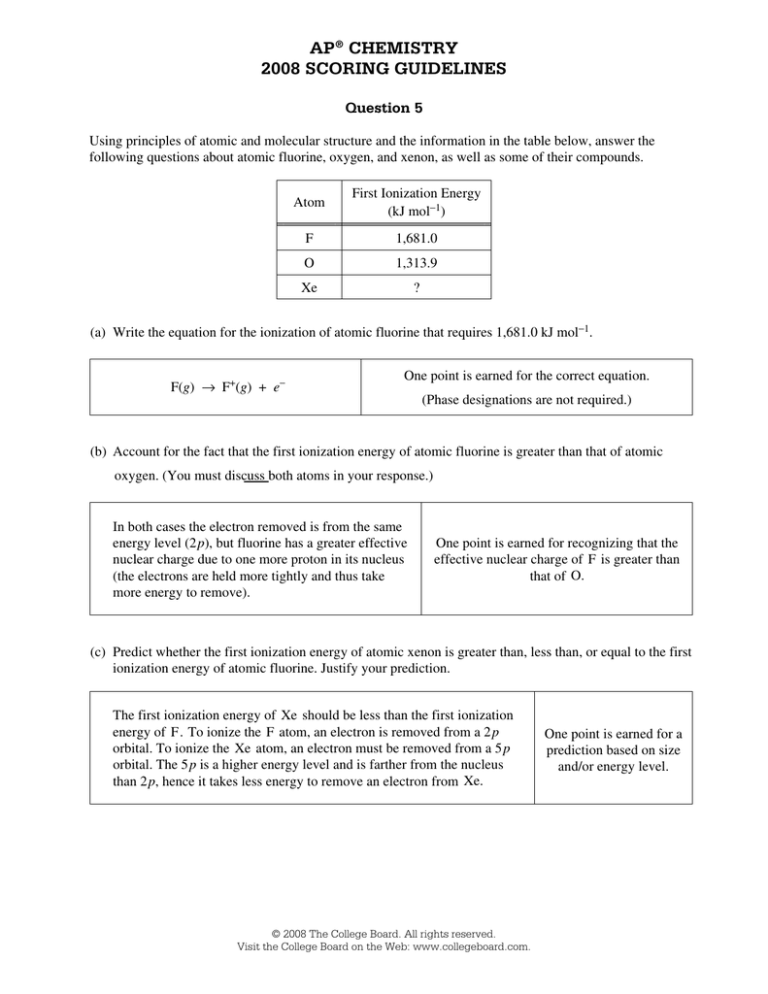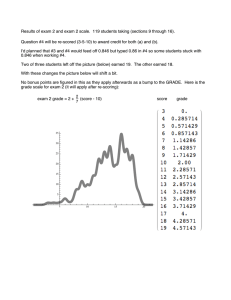
AP® CHEMISTRY
2008 SCORING GUIDELINES
Question 5
Using principles of atomic and molecular structure and the information in the table below, answer the
following questions about atomic fluorine, oxygen, and xenon, as well as some of their compounds.
Atom
First Ionization Energy
(kJ mol−1)
F
1,681.0
O
1,313.9
Xe
?
(a) Write the equation for the ionization of atomic fluorine that requires 1,681.0 kJ mol-1.
F(g) → F+(g) + e−
One point is earned for the correct equation.
(Phase designations are not required.)
(b) Account for the fact that the first ionization energy of atomic fluorine is greater than that of atomic
oxygen. (You must discuss both atoms in your response.)
In both cases the electron removed is from the same
energy level (2p), but fluorine has a greater effective
nuclear charge due to one more proton in its nucleus
(the electrons are held more tightly and thus take
more energy to remove).
One point is earned for recognizing that the
effective nuclear charge of F is greater than
that of O.
(c) Predict whether the first ionization energy of atomic xenon is greater than, less than, or equal to the first
ionization energy of atomic fluorine. Justify your prediction.
The first ionization energy of Xe should be less than the first ionization
energy of F. To ionize the F atom, an electron is removed from a 2p
orbital. To ionize the Xe atom, an electron must be removed from a 5p
orbital. The 5p is a higher energy level and is farther from the nucleus
than 2p, hence it takes less energy to remove an electron from Xe.
© 2008 The College Board. All rights reserved.
Visit the College Board on the Web: www.collegeboard.com.
One point is earned for a
prediction based on size
and/or energy level.
AP® CHEMISTRY
2008 SCORING GUIDELINES
Question 5 (continued)
(d) Xenon can react with oxygen and fluorine to form compounds such as XeO3 and XeF4 . In the boxes
provided, draw the complete Lewis electron-dot diagram for each of the molecules represented below.
XeF4
XeO3
One point is earned for each
correct Lewis electron-dot
diagram.
Omission of lone pairs of
electrons on the O or F atoms
results in a one-time, 1-point
deduction.
(e) On the basis of the Lewis electron-dot diagrams you drew for part (d), predict the following:
(i) The geometric shape of the XeO3 molecule
Trigonal pyramidal
One point is earned for a shape that is
consistent with the Lewis electron-dot diagram.
(ii) The hybridization of the valence orbitals of xenon in XeF4
sp3d 2
One point is earned for the hybridization
consistent with the Lewis electron-dot diagram.
(f) Predict whether the XeO3 molecule is polar or nonpolar. Justify your prediction.
The XeO3 molecule would be polar because it
contains three polar Xe –O bonds that are
asymmetrically arranged around the central Xe
atom (i.e., the bond dipoles do not cancel
but add to a net molecular dipole with the Xe
atom at the positive end).
One point is earned for the answer
that is consistent with the shape
indicated in part (e)(i).
One point is earned for an explanation
correctly related to the shape in part (e)(i).
© 2008 The College Board. All rights reserved.
Visit the College Board on the Web: www.collegeboard.com.
©2008 The College Board. All rights reserved.
Visit the College Board on the Web: www.collegeboard.com.
©2008 The College Board. All rights reserved.
Visit the College Board on the Web: www.collegeboard.com.
©2008 The College Board. All rights reserved.
Visit the College Board on the Web: www.collegeboard.com.
©2008 The College Board. All rights reserved.
Visit the College Board on the Web: www.collegeboard.com.
©2008 The College Board. All rights reserved.
Visit the College Board on the Web: www.collegeboard.com.
©2008 The College Board. All rights reserved.
Visit the College Board on the Web: www.collegeboard.com.
AP® CHEMISTRY
2008 SCORING COMMENTARY
Question 5
Overview
This question was designed to assess student understanding of the structure and properties of atoms and
molecules. In parts (a) through (c) students had to demonstrate their understanding of ionization energy and
provide explanations for its variance among different atoms. In parts (d) through (f) students were required to
sketch Lewis electron-dot diagrams, identify molecular shape and hybridization, and predict molecular polarity.
Sample: 5A
Score: 8
This response earned 8 out of 9 points: 1 for part (a), 1 for part (c), 2 for part (d), 1 for part (e)(i), 1 for
part (e)(ii), and 2 for part (f). The point was not earned in part (b); explanations based on electronegativity did not
earn credit.
Sample: 5B
Score: 5
The point was earned in part (a). The point was earned in part (b) for the reference to a “stronger positive charge”;
other factors discussed are not relevant but do not negate the credit earned for the response. The answer to part (c)
is not correct. Both points were earned in part (d); students generally did well in this part. The answer to part (e)(i)
is not correct. The point was earned in part (e)(ii). The answer to part (f) must be consistent with the response
given in part (e)(i); no credit was earned in part (f) because “Polar” is not consistent with “Trigonal Planar.”
Sample: 5C
Score: 1
The response to part (a) is not correct. The answer to part (b) does not address the effective nuclear charge, so
the point was not earned. The answer to part (c) is incorrect. Neither point was earned in part (d); the Lewis
electron-dot diagram for XeO3 is missing one lone pair of electrons on each O atom, and electrons are also
missing in the diagram for XeF4. Part (e)(i) earned 1 point for being consistent with the Lewis electron-dot
diagram for XeO3 given in part (d). The answer to part (e)(ii) is not correct. The answer to part (f) is not correct
for a trigonal-pyramidal-shaped molecule.
© 2008 The College Board. All rights reserved.
Visit the College Board on the Web: www.collegeboard.com.

